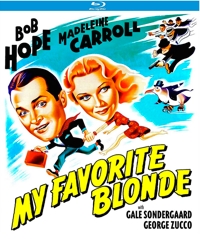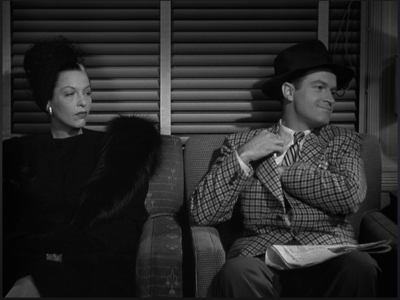 Grade: B/B-
Grade: B/B-
Comedy
Not rated (would be PG)
Comedian Bob Hope received a record five honorary Oscars and also has a record four stars on the Hollywood Walk of Fame. But those awards are dimmed by the Congressional Gold Medal he received, the Presidential Medal of Freedom that Pres. Lyndon B. Johnson awarded him, the Medal of Liberty he got from Pres. Ronald Reagan, the National Medal of Arts he received from Pres. Bill Clinton, the knighthoods he received from two Popes, and the honorary knighthood that Great Britain bestowed upon him. In fact, Hope has almost as many high honors as he does films—and he starred in 54 of them during a career that spanned nearly 80 years.
Yeah, you’re probably thinking, but are his films any good? For the most part, Hope’s films fall in the three-star category (out of four). And speaking of stars, five-star Gen. Dwight D. Eisenhower presented Hope with the Medal of Merit “in recognition of his wartime contributions to morale on the homefront as well as on virtually every war front.” Which is to say, besides entertaining the troops, as he did his entire life starting in 1941, Hope also starred in a number of wartime films that both entertained audiences and reinforced patriotic themes.
 My Favorite Blonde is one of those WWII-era films. This 1942 black-and-white comedy features Hope in a familiar role: a vaudevillian who unwittingly finds himself in the middle of an adventure or intrigue. This time Larry Haines (Hope) and his trained roller-skating penguin Percy are headed for Los Angeles, where the movies want to sign the penguin—not his trainer. But that was before he ran into British secret agent Karen Bentley, or rather she planted a scorpion brooch on him containing the flight plans for 100 American bombers. Back then Americans weren’t as paranoid as they are now, but there was still a sense that a “fifth column” might be operating as underground spies in the U.S.A. German agents (led by screen veteran Gale Sondergaard) are in pursuit, and as irrational as it seems for plans for a European war to start out in New York City, move to Albany, then Chicago, and finally L.A., what entertains about Bob Hope movies is less the plotting than it is Hope’s character, antics, and interaction with a woman that he eventually gets—if Road picture crooner-crony Bing Crosby isn’t co-starring.
My Favorite Blonde is one of those WWII-era films. This 1942 black-and-white comedy features Hope in a familiar role: a vaudevillian who unwittingly finds himself in the middle of an adventure or intrigue. This time Larry Haines (Hope) and his trained roller-skating penguin Percy are headed for Los Angeles, where the movies want to sign the penguin—not his trainer. But that was before he ran into British secret agent Karen Bentley, or rather she planted a scorpion brooch on him containing the flight plans for 100 American bombers. Back then Americans weren’t as paranoid as they are now, but there was still a sense that a “fifth column” might be operating as underground spies in the U.S.A. German agents (led by screen veteran Gale Sondergaard) are in pursuit, and as irrational as it seems for plans for a European war to start out in New York City, move to Albany, then Chicago, and finally L.A., what entertains about Bob Hope movies is less the plotting than it is Hope’s character, antics, and interaction with a woman that he eventually gets—if Road picture crooner-crony Bing Crosby isn’t co-starring.
 Hope was known for his self-deprecating humor, a bumbling “cowardice” that reluctantly turned to bravery, snappy comebacks and one-liners, improvisations and impersonations, and his banter. My Favorite Blonde is a gentle kind of comedy that has more cleverness than laughs, but Hope sells it with a warm and winning personality. And you can’t find a better second banana than Percy the Penguin. When all is said and done, it’s a lighter version of espionage thrillers, though curiously, “British agents” or “German agents” are never mentioned by name, and neither is Germany, World War II, or Nazis. The closest the film comes is when Hope’s character calls the bad guys “nasties.” Audiences back then would have gotten the joke, but back then they also knew that there was as much at stake on the homefront as well as overseas. They were willing to suspend belief and think that agents operating clandestinely on American soil was a real possibility.
Hope was known for his self-deprecating humor, a bumbling “cowardice” that reluctantly turned to bravery, snappy comebacks and one-liners, improvisations and impersonations, and his banter. My Favorite Blonde is a gentle kind of comedy that has more cleverness than laughs, but Hope sells it with a warm and winning personality. And you can’t find a better second banana than Percy the Penguin. When all is said and done, it’s a lighter version of espionage thrillers, though curiously, “British agents” or “German agents” are never mentioned by name, and neither is Germany, World War II, or Nazis. The closest the film comes is when Hope’s character calls the bad guys “nasties.” Audiences back then would have gotten the joke, but back then they also knew that there was as much at stake on the homefront as well as overseas. They were willing to suspend belief and think that agents operating clandestinely on American soil was a real possibility.
My Favorite Blonde was popular enough that Hope was enlisted to immediately make My Favorite Spy as a follow-up that very same year, and revived the idea two years after the war ended with My Favorite Brunette. Hope fans disagree whether the best of the three is “Blonde” or “Brunette,” but if you and your family like old movies either one is worth your time, and this Kino Lorber Blu-ray is worth adding to your home movie collection.
 I will admit to having a Hope bias. I like his persona and like his quips and ad-libs. At one point Larry tells spy Karen Bentley (Madeleine Carroll) that he’s going to call his agent. “Do you think he’ll help?” “He’d better. If I get the electric chair, he gets 10 percent of the current.” Later, when they commandeer a biplane—yes, you could call this film an early rendition of Planes, Trains, and Automobiles—he asks her, “You sure you know how to run this thing?” She says, “Sure, my brother’s a British ace.” “Yeah, well my uncle’s a dogcatcher, but I can’t bark.”
I will admit to having a Hope bias. I like his persona and like his quips and ad-libs. At one point Larry tells spy Karen Bentley (Madeleine Carroll) that he’s going to call his agent. “Do you think he’ll help?” “He’d better. If I get the electric chair, he gets 10 percent of the current.” Later, when they commandeer a biplane—yes, you could call this film an early rendition of Planes, Trains, and Automobiles—he asks her, “You sure you know how to run this thing?” She says, “Sure, my brother’s a British ace.” “Yeah, well my uncle’s a dogcatcher, but I can’t bark.”
Hope’s characters never took themselves too seriously, and his films were always pleasant diversions rather than films that made you feel tense or anxious. They were escapist fare, entertainments that were intended to take people’s minds off whatever ailed them. And Hope lived to be 100, proving that laughter may indeed be the best medicine.
Entire family: No (under age 10 might find it slow going and not worth the penguin antics)
Run time: 78 min., Black-and-White
Aspect ratio: 1.37:1
Featured audio: DTS Mono
Studio/Distributor: Kino Lorber
Bonus features: C-
Trailer
Amazon link
Not rated (would be PG for mild violence, smoking, and drinking)
Language: 1/10—Nothing caught my attention, but there may have been a few lesser swearwords that slipped past
Sex: 0/10—Squeaky clean on this front, unless you consider a kiss from fully clothed people sexual
Violence: 3/10—For a parody of spy thrillers this one is pretty tame, with some fisticuffs, some shooting, a conk on the head, a kick in the pants, and some crashes—the latter, really, the most startling
Adult situations: 3/10—A man and woman who aren’t married travel together and pretend to be married at one point
Takeaway: The Princess and the Pirate remains the most family-friendly Bob Hope picture, but older children might enjoy this minor blast from the past


Leave a comment